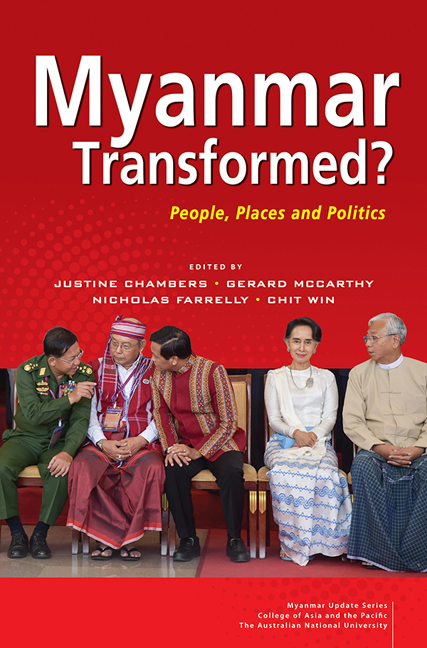Book contents
- Frontmatter
- Contents
- List of Tables
- List of Figuress
- Acknowledgements
- Contributors and Editors
- Part I Introduction
- Part II People
- Part III Places
- Part IV Politics
- 9 Partnership in Politics: The Tatmadaw and the NLD in Myanmar since 2016
- 10 From Ceasefire to Dialogue: The Problem of “All-Inclusiveness” in Myanmar's Stalled Peace Process
- 11 Securitization of the Rohingya in Myanmar
- 12 Forming an Inclusive National Identity in Myanmar: Voices of Mon People
- Part V Epilogue
- Abbreviations and Key Terms
- Index
10 - From Ceasefire to Dialogue: The Problem of “All-Inclusiveness” in Myanmar's Stalled Peace Process
from Part IV - Politics
Published online by Cambridge University Press: 12 February 2019
- Frontmatter
- Contents
- List of Tables
- List of Figuress
- Acknowledgements
- Contributors and Editors
- Part I Introduction
- Part II People
- Part III Places
- Part IV Politics
- 9 Partnership in Politics: The Tatmadaw and the NLD in Myanmar since 2016
- 10 From Ceasefire to Dialogue: The Problem of “All-Inclusiveness” in Myanmar's Stalled Peace Process
- 11 Securitization of the Rohingya in Myanmar
- 12 Forming an Inclusive National Identity in Myanmar: Voices of Mon People
- Part V Epilogue
- Abbreviations and Key Terms
- Index
Summary
A key principle underpinning Myanmar's peace process has been the principle of “all-inclusiveness.” Initially, this principle represented a commitment to the inclusion of all ethnic armed organizations (EAOs) in a nation-wide ceasefire agreement (NCA) that would serve as a basis for reconciliation, political dialogue and negotiation over constitutional reform. When President Thein Sein's transition government (2011–16) began making peace overtures, the principle was widely embraced by EAOs and the military, and ultimately enshrined in the text of the NCA. When Aung San Suu Kyi's National League for Democracy (NLD) came to power in 2016 and made the peace process its top priority it, too, championed the principle of “all-inclusiveness.” However, as the NLD and the military struggle to convince more EAOs to sign the NCA, it has become apparent that, for all its good intentions, the principle of “all-inclusiveness” has become an obstacle to the peace process. This chapter reviews the peace process to date to examine the problems that have emerged around the concept of “all-inclusiveness.” Drawing on interviews with signatories of the NCA and other key stakeholders, the chapter highlights a central challenge confronting the government in its efforts to advance Myanmar's stalled peace process.
THE ORIGINS OF INCLUSIVENESS
When the NLD was elected in 2015 as Myanmar's first civilian government in more than half a century, NLD leader Aung San Suu Kyi declared that reconciliation with the country's fractured and warring ethnic groups would be her government's top priority. The NLD assumed leadership of a peace process initiated under Thein Sein's Union Solidarity and Development Party (USDP)-led transition government (2011–16). As part of wider efforts to end six decades of conflict and to build a new political culture based on compromise and consensus, President Thein Sein made peace overtures to the country's multiple ethnic armed organizations (EAOs). The USDP government acknowledged that peace could not be achieved if the central government refused to negotiate political settlements with EAOs or provide stability and development opportunities for the frontier regions. From 2011 the government initiated a series of talks and confidence-building measures designed to eventually lead to peace agreements and political integration into a reformed federal democratic system of government.
- Type
- Chapter
- Information
- Myanmar Transformed?People, Places and Politics, pp. 231 - 250Publisher: ISEAS–Yusof Ishak InstitutePrint publication year: 2018

